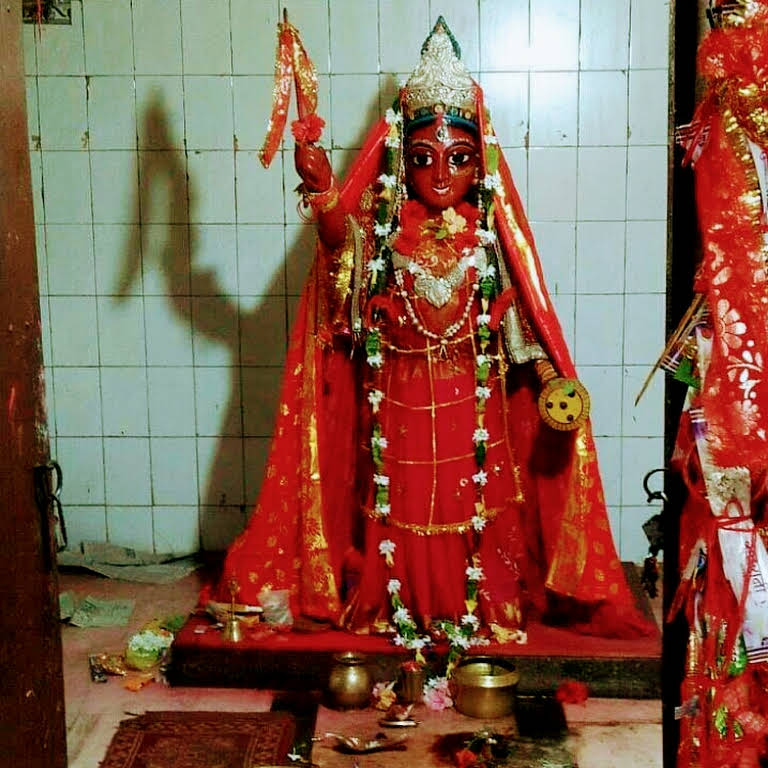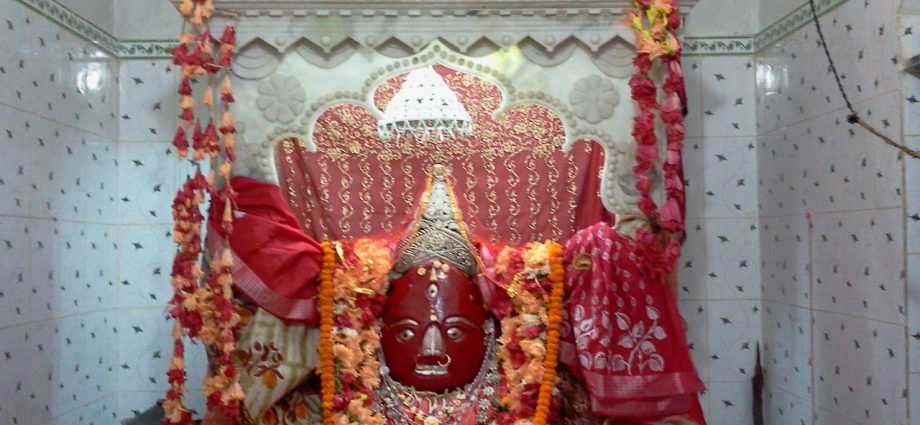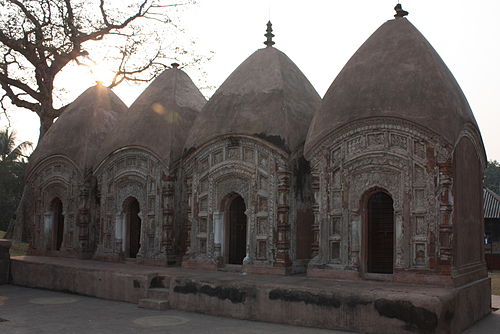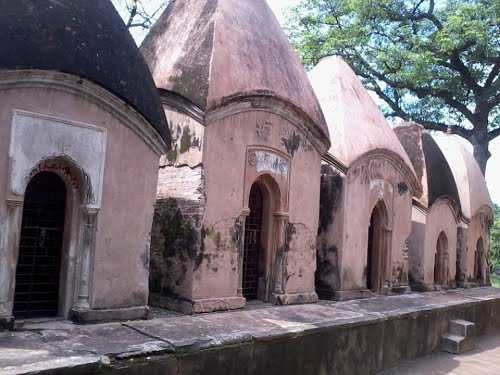Bashuli or Bishalakshi Temple is a traditional and famous temple of Nanur. To discuss about this temple, itcovers the lion’s shareby the famous Bengali poet’s story of fourteen century, Badu Chandidas. This Badu Chandidas Chaitanya, the author of the poem Srikrishnakirtan, gained a reputation as the author of Vaishnavism in earlier Bengali literature. According to some people, this Badu Chandidas was a resident of Chhatna in Bankura district. Although there is disagreement about the birthplace of Baru Chandidas.There are a few notable references to Chandidas in the verses of Rami or Rammoni. There was a special relationship with Chandidas, and the lover poet himself dispelled that suspicion by saying, ” শুনোরজকিনী রামী ও দুটি চরণ তলে শীতল জানিয়া শরন লইনু আমি ” which means, “Listen, Rajkini Rami, I am staying under those feet, knowing that the feetsare cool.” Rami was a daughter of Dhopa( washer man), who lived in a village calledTehaigram, far away from Nanur. After the rules of time, Rami was blessed by the mother Bishalakshifor the devotion and service she offer from her heart, even though she was once the daughter of Dhopa.
Thakur Chandidas gave Rami the right to enter the temple and openly serve Mahavidya Bashuli Devi. Rami devoted herself to the service of the Goddess with reverence. There are three theories about the death of Chandidas in Nanur and its adjoining areas. First, Chandidas was a famous kirtaniya of that era. It has been ordered by Bishalakshithat if he went to perform kirtan somewhere in north of Nanur, he would die. One day Chandidas went to the north of Nanur to perform kirtan in the name of Radha Krishna. During the kirtan, the roof of the temple collapsed and he died. According to the second doctrine, Chandidas had a melodious voice. At that timeof Kirnahar or Nanur region was kirgyz khan. His daughter was attracted to the poet. And the ruler was very angry. According to tradition of the ruler, Chandidas was tied to the back of an elephant and brutally whipped to death. The third reason is that where Chandidas now has heaped, there used to be a temple of Goddess Bishalakshi.There was an atchala house in front of it, where the devotee poet keep practicing happily.The daughter of the Nawab, who was attracted to the poet, used to go to the temple almost every day to sing her song. One day when, the self-forgetful devotee poet is intoxicated with kirtan songs Nawab’s daughter and Rami were present there. As soon as the news reached the Nawab, the temple was smashed by cannon fire. The Ma Bishalakshi temple was reduced to rubble. Nanur’s heap bears all thr witness to the past.

As many historians believe, the attraction of Nawab’s daughter Matantar, towards Chandidas led to the destruction of the MaaBishalakshi temple and the death of the poet. According to some people, the killing was necessary to stop the spread of Vaishnavism in Muslim-majority areas. This is a very short story of Chandidas, the famous Padakarta of Vaishnava verses. It is estimated that the poet was buried with the devotees about 600 years ago in the mound of Chandidas of Nanur. The mound really looks like a ruin. Mahavidya Bishalakshi, was also lies under this. After the death of Chandidas, the influence of Vaishnava Hinduism had somewhat waned in the Nanur area. By the order of the Nawab, everyone completely stopped going to that place. Gradually, the memory of Chandidas became a dense forest. There is a rumor that one day a dairy cow of Tiligrihabadhu got lost.The bride came looking for her cow and found her cow under a banyan tree in the middle of Chandidas’ memorial mound. Surprisingly, she saw the cow dropping milk by herself. She was surprised, and returned to the house. That night she received a dream that the Goddess Bishalakshi was standing under the banyan tree so that she could worship her every evening. If it is spread to someone, then death is inevitable. Then every day Tilibadhu used to light the evening lamp over that place. There was a pond west of that heap. And was named by SarojaPukur. The water of this pond was as sacred as the Ganges for the blessings of the goddess. Thus, seeing Tilibudhu going out every evening, her husband became suspicious about her. One day she reluctantly told her husband about the incident and then died in a strange way. In such cases, everything seems to be true to her husband. TiliMahasaya had a friend named Umacharan Bhattacharya, and he told him everything. Then, one day afterrescuing the idol, the two took refuge in the local zamindar. A new temple was built in favor of the benevolent zamindar. Bhattacharya Mahasaya is entrusted with all the responsibilities of worshiping Bishalakshi. Even today his descendants continue to worship in the traditional way. The present residence of the descendants of TiliMahasaya is in Ketugram of Burdwan district. This new temple was built 300 years ago.Temple with four-cornered roof. It had various designs on it. Later, when parts of the designs are damaged, all the designs are removed and repaired. Daily worship is done in the temple. The special feature of the puja is the daily consumption of non-vegetarian food. One day of the year all the villagers worship the village Goddess in a solemn manner. The day is fixed on Saturday or Tuesday after the 20th day of the month of Ashar. Also this idol is worshiped as Kali in the new moon of Boishakh, Jyastha, Kartik and Magh month. This Bashuli temple is located at a distance of 22 km from Bolpur and 9 km from Nanur on the Kirnahar Road from Nanur. Just opposite of Nanur police station, you can see Chandidas’s immortal words written on the head of a white Taran. “কহেচণ্ডীদাস, শুনহমানুষভাই, সবারউপরেমানুষসত্যতাহারউপরেনাই”, which means humanity is greatest of all, nothing more than this. From there if you take the narrow path of 200 meters, you could easily reach out to his house. Although the mound dates back to the 14th century, the construction of these temples dates back to the 17th-18th centuries. There are 16 temples here (but many says that there are 14 temples only). At the entrance, there is a four-storied temple, followed by a rectangular courtyard on the right and one temple after another.Upon entering, there is a root type temple of the Goddess Basuli without ornaments. Of these temples, the four Charchala temples on the left have remarkably beautiful stucco work.Behind this rectangular area there are several Charchala temples in the area. Apart from Bashuli, other temples are considered to be the temples of Shiva. In the vicinity of this temple there was a theater for performing the screenplay of the poet Chandidas. Poet’s father Bhavanicharan was the priest of this temple. After his death, Chandidas was given the responsibility of worshiping at this temple. This temple has a flat roof but has a dome at its head. And there are 5 brass pitchers on the top of that dome. At the top of the jugs are attached large tridents. In front of the temple there is an open play attic or verandah.There are three arched entrances to this temple. At one time the temple was adorned with various ornaments, such as two terracotta temples with eight sheds. The terracotta ornaments are of ordinary quality but the quality of the work of the stucco is very good.

নানুরের বাশুলি মন্দির
নানুরের বাশুলি মন্দির বাশুলি বা বিশালাক্ষী মন্দির নানুরের ঐতিহ্যশালী এবং বিখ্যাত একটি মন্দির। এই মন্দিরটির সম্বন্ধে আলোচনা করতে গেলে সিংহভাগ অংশ জুড়ে থাকে চতুর্দশ শতকের বিখ্যাত বাঙালী কবি বড়ু চণ্ডীদাসের কাহিনী। শ্রীকৃষ্ণকীর্তন কাব্যের রচয়িতা এই বড়ু চণ্ডীদাস চৈতন্য পূর্ববর্তী বাংলা সাহিত্যে বৈষ্ণবপদাবলী রচয়িতা হিসেবে সুনাম অর্জন করেছিলেন। কারো কারো মতে এই বড়ু চণ্ডীদাস বাঁকুড়া জেলার ছাতনার অধিবাসী ছিলেন। যদিও বড়ু চণ্ডীদাসের জন্মভূমি নিয়ে মতানৈক্য আছে। চণ্ডীদাসের পদাবলী কয়েকটি উল্লেখযোগ্য উল্লেখ আছে রামী বা রামমনির কথা। চন্ডীদাসের সঙ্গে একটি বিশেষ সম্পর্ক ছিল, সেই সংশয় নিরসন ঘটিয়ে প্রেমিক কবি নিজেই বলেছিলেন “শুনো রজকিনী রামী ও দুটি চরণ তলে শীতল জানিয়া শরন লইনু আমি ।” রামী ছিলেন ধোপার মেয়ে, নানুর থেকে ছয়মাইল দূরে “তেহাই” গ্রামে ছিল তার বাস। কালের নিয়মে একসময় অন্তরের ভক্তি ও সেবার দারায় ধোপার মেয়ে হয়েও রামী অনুগ্রহ লাভ করেছিলেন মা বিশালক্ষীর। রামীকে মন্দিরে প্রবেশাধিকার ওপ্রকাশ্যভাবে মহাবিদ্যা বাশুলী দেবীর সেবার অধিকার দিয়েছিলেন ঠাকুর চন্ডীদাস । দেবীর সেবায় নিজেকে উৎসর্গ করেছিলেন রামী অন্তরের শ্রদ্ধা উজাড় করে ।
চন্ডীদাসের মৃত্যু সম্বন্ধে তিন ধরনের মতবাদ প্রচলিত আছে নানুর ও তার সংলগ্ন অঞ্চলগুলিতে। প্রথমত, সে যুগের এক খ্যাতিমান কীর্তনীয়া ছিলেন চন্ডীদাস । বিশালাক্ষীর আদেশ ছিল নানুরের উত্তরে কোথাও কীর্তন করতে গেলে তার মৃত্যু হবে । কোন একদিন রাধা কৃষ্ণের নামে আত্মহারা হয়ে গিয়ে নানুরের উত্তরে কীর্তন করতে চলে গিয়েছিলেন চন্ডীদাস ।সেখানে নাকি কীর্তন চলাকালীন মন্দিরের ছাদ ভেঙে তার মৃত্যু হয় । দ্বিতীয় মতবাদ, সুললিত কণ্ঠের অধিকারী ছিলেন চন্ডীদাস। সেই সময় কীর্ণাহার বা নানুর অঞ্চলের শাসক ছিলেন কিরগীজ খাঁ। তাঁর কন্যা আকৃষ্ট হয়েছিলেন কবির প্রতি । এতে অত্যন্ত রুষ্ট হয়েছিলেন শাসক। পরম্পরাগত কথাঅনুসারে, শাসক চন্ডীদাস কে হাতির পিঠে বেঁধে নির্মমভাবে বেত্রাঘাত করলে তার মৃত্যু হয়। তৃতীয় কারণ , বর্তমানে যেখানে চন্ডীদাসের ঢিবি আছে পূর্বে সেখানে ছিল দেবী বিশালক্ষী মন্দির । এর সামনে ছিল একটি আটচালা ঘর ।সেই ঘরে বসে ভক্ত কবি গান গাইতেন পরমানন্দে। শোনা যায় এই যে নবাবের কন্যা , যিনি কবির প্রতি আকৃষ্ট হয়েছিলেন তার গান শোনার জন্য সেই কন্যা প্রায় দিনই মন্দিরে যেতেন। একদিন আত্মবিস্মৃতি সাধক কবি মত্ত হয়ে রয়েছেন কীর্তন গানে। সেখানে উপস্থিত ছিলেন নবাব আর রামী। এই সংবাদ নবাবের কাছে পৌঁছনো মাত্র কামানের তোপ দেগে মন্দির ভেঙে চুরমার করে দেওয়া হয়। ধ্বংসস্তূপে পরিণত হয় মা বিশালক্ষী মন্দির। নানুরের ঢিবি অতীতের সাক্ষ্য বহন করছে । অনেক ঐতিহাসিকরা যেমন মনে করেন ,নবাব কন্যা মতান্তরে বেগম চন্ডীদাস এর প্রতি আকৃষ্ট হওয়ার কারণেই মা বিশালক্ষী মন্দির ধ্বংস প্রাপ্ত হয়েছিল ও কবির মৃত্যু ঘটেছিল। আবার কারো কারো মতে, মুসলিম অধ্যুষিত অঞ্চলে বৈষ্ণবমতের প্রচার বন্ধ করার জন্য এ হত্যার প্রয়োজন হয়ে পরেছিল। এই হল বৈষ্ণব পদাবলীর বিখ্যাত পদকর্তা চণ্ডীদাস এর অতি সংক্ষিপ্ত জীবনের কথা । নানুরের চন্ডীদাসের স্মৃতিবিজড়িত ঢিবিতে প্রায় ৬০০ বছর আগে ভক্তদের সঙ্গে কবি চাপা পড়েছিলেন বলে অনুমান। প্রকৃতই ঢিবি দেখতে ধ্বংসস্তূপের মত ।
মহাবিদ্যা বিশালক্ষী এর নিচে ছিলেন। চন্ডীদাসের মৃত্যুর পর বৈষ্ণব হিন্দু ধর্মের প্রভাব বেশ কিছুটা স্তিমিত হয়ে পড়েছিল নানুর এলাকায়। নবাবের আদেশে সম্পূর্ণভাবে বন্ধ হয়ে গিয়েছিল সেই ঢিবিতে সবার যাওয়া। ধীরে ধীরে ঘন জঙ্গলে পরিণত হয়েছিল চন্ডীদাসের স্মৃতি বিজড়িত স্থান।। একটি জনশ্রুতি আছে যে একদিন একটি তিলিগৃহবধূর দুগ্ধবতী গাভী খুঁজে পাওয়া যাচ্ছিল না। সেই বধূ তার গাভীকে খুজতে খুজতে এসে চন্ডীদাসের স্মৃতিবিজড়িত ঢিবি র মাঝখানে একটি বটগাছের নিচে খুঁজে পায় তার গরুকে। আশ্চর্যভাবে তিনি দেখেন আপনা থেকেই দুধ ঝরে পড়ছে গাভীর। অত্যন্ত আশ্চর্য হয়ে তিনি বধু বাড়ি ফিরে আসেন। সেদিন রাতেই তিনি স্বপ্নাদেশ পান যে বট গাছের তলায় দেবী বিশালক্ষী অবস্থান করছেন প্রতি সন্ধ্যায় যেন তাকে সন্ধ্যা দেওয়া হয় । এ কথা কাউকে বললে মৃত্যু অবধারিত। তারপর প্রতিদিন তিলিবধূ সন্ধ্যা প্রদীপ দিতেন। ওই ঢিবির পশ্চিমে একটি পুকুর ছিল। তার নামছিল সরোজা পুকুর। তার জল দেবীর আশীর্বাদে গঙ্গার মত পবিত্র ছিল। এইভাবে প্রতিদিন সন্ধ্যায় তিলিবধুর বাইরে যাওয়া দেখে স্বামীর মনে সন্দেহ হল । একদিন ব্যাপারটা জানতে চাইলেন অনিচ্ছাসত্ত্বেও স্বামীকে তিনি আনুপূর্বিক সব ঘটনা জানান ও তারপরেই অদ্ভুত ভাবে মারা যান। এরকম ঘটনায় সমস্ত ব্যাপারটা সত্য বলে মনে হলো স্বামীর। তিলি মহাশয়ের উমাচরণ ভট্টাচার্য নামে এক বন্ধু ছিল ।সব কথা তাকে খুলে বললেন ।তারপর এক মহাষ্টমীর ভোরে দুজনে গিয়ে মাটি খুঁড়ে উদ্ধার করলেন দেবী বিশালক্ষীকে। মূর্তি উদ্ধার এর পর দু’জনে শরণাপন্ন হলেন স্থানীয় জমিদারের ।

সদাশয় জমিদারের অনুকূলে নতুন মন্দির নির্মাণ হল। বিশালক্ষী কে পূজোর সমস্ত দায়িত্ব অর্পিত হলো ভট্টাচার্য মহাশয় এর উপর । আজও তাঁর বংশধর প্রম্পরাগত ভাবে পূজা করে চলেছেন । তিলি মহাশয়ের বংশধরদের বর্তমান বাস বর্ধমান জেলা কেতুগ্রামে। এই নতুন মন্দির নির্মিত হয় তিনশো বছর আগে। চার কোনা ছাদ বিশিষ্ট মন্দির । এর গায়ে নানা রকম নকশা আঁকা ছিল। পরবর্তীকালে নকশাগুলি অংশবিশেষ নষ্ট হয়ে গেলে ,সমস্ত নকশা তুলে দিয়ে সংস্কার ও মেরামত করা হয় । নিত্য পূজা হয় মন্দিরে। পূজার বিশেষ বৈশিষ্ট্য হলো প্রতিদিন আমিষ সহ অন্নভোগ । বছরের একদিন সমস্ত গ্রামবাসীরা গ্রাম্যদেবীর পুজো করেন সাড়ম্বরে। দিনটি নির্ধারিত হয় আষাঢ় মাসের কুড়ি তারিখের পর শনি কিংবা মঙ্গলবার । এছাড়াও বৈশাখ-জ্যৈষ্ঠ কার্তিক , মাঘ মাসের আমাবস্যায় কালী রূপে এই মূর্তির পূজা করা হয় । নানুর থেকে বোলপুর কীর্ণাহার রোডে বোলপুর থেকে ২২ কিমি এবং নানুর থেকে ৯ কিমি দূরে অবস্থিত এই বাশুলী মন্দির। নানুর থানার ঠিক উল্টোদিকে দেখা যাবে একটি সাদা রঙের তোরণের মাথায় লেখা আছে চণ্ডীদাসের সেই অমর বাণী “কহে চণ্ডীদাস, শুনহ মানুষ ভাই, সবার উপরে মানুষ সত্য তাহার উপরে নাই” এখান থেকেই ওই সরু রাস্তা ধরে মাত্র ২০০ মিটার গেলেই আপনি পৌঁছে যাবেন বড়ু চণ্ডীদাসের ভিটেয়। ঢিবিটি চতুর্দশ শতকের হলেও এই মন্দিরগুলির নির্মাণ কাল ১৭-১৮শ শতক। এখানে মোট ১৬টি মন্দির আছে (কিন্তু অনেকে বলেন এখানে মন্দিরের সংখ্যা ১৪টি)। ঠিক প্রবেশ পথে একটি চারচালা মন্দির তার পরে ডানদিকে একটি আয়তাকার উঠোন ঘিরে তার চারিদিকে সাজানো একের পর এক মন্দির। ওখানে ঢুকেই দেবী বাশুলীর অলঙ্করণ বিহীন এক শিখরযুক্ত দালান টাইপের মন্দির। এই মন্দিরগুলির মধ্যে বাঁ দিকের চারটি চারচালা মন্দিরে অসাধারণ সুন্দর স্টাকো বা পঙ্খের কাজ আছে। এই আয়তাকার ক্ষেত্রটির পেছনেই আরো বেশ কয়েকটি চারচালা মন্দির আছে। বাশুলি বাদে অন্য মন্দিরগুলি শিবের মন্দির বলেই মনে করা হয়। এই দেবমন্দিরের পার্শ্ববর্তী স্থানে কবি চণ্ডীদাসের চিত্রনাট্যগীতি পরিবেশনের নাট্যশালা ছিল। কবির বাবা ভবানীচরণ ছিলেন এই মন্দিরের পুরোহিত। তাঁর মৃত্যুর পর চণ্ডীদাস এই মন্দিরের পূজা আরাধনার দায়িত্ব পান। এই মন্দিরটি সমতল ছাদওয়ালা কিন্তু তার মাথায় গম্বুজ আছে। এবং ওই গম্বুজের মাথায় ৫টি পিতলের কলস আছে। কলসগুলোর শীর্ষে বড় বড় ত্রিশূল সংযুক্ত আছে। মন্দিরটির সামনে একটি উন্মুক্ত খোলা চাতাল বা বারান্দা আছে। এই মন্দিরে প্রবেশের জন্য তিনটি ধনুকাকৃতির প্রবেশ পথ আছে। একটা সময় এই মন্দিরটি নানা রকমের অলঙ্করণ শোভিত ছিল, যেমন দুটি টেরাকোটার মন্দিরই আট চালাযুক্ত। এখানকার টেরাকোটার অলঙ্করণগুলি সাধারণ মানের হলেও স্টাকোর কাজের মান খুবই উন্নত।
This piece has been authored by Sajal Mondal and Mrighankhi Das, for a joint initiative by Baarta Today and the Indic Collective.





